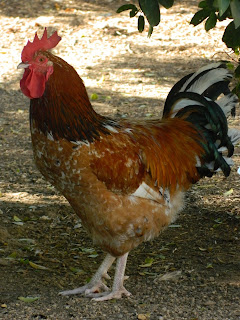He's so big and beautiful! Not an Aloha, he's actually a pure Sussex. A mix of Buff Sussex and Speckled Sussex. Technically, he is mottled. He does have some spots. However, they are very small dots of white. Not the riot of crazy spots that I like to see on an Aloha!
What that means - genetically - is that if I put him with my spotted hens, every single chick of his will have spots. Some will have less spotting, since Dad doesn't have a lot, but every chick will share some of his big size, so it's just a matter of hatching lots and lots and lots of chicks, looking for the biggest chicks with the most spots, and choosing those to keep.
It sounds so easy.
Unfortunately, my Big Orange Stud turned out to be a Big Orange Dud. My rooster needs Viagra. (So many jokes abound!) After I took the Dun rooster out of the breeding pen, and replaced him with this big boy, the eggs slowly became . . . infertile.
 |
| Huge pile of infertile eggs, going into the trash. |
When you see the hens in there, you'll understand why I'm upset. Here's a few:
 |
| Above and below: Same hen. Orange spotted. |
 |
| This orange spotted hen is the best sized true Aloha to date. |
 |
| Pure Sussex hen - Buff with Mottling. |
All of these hens shown are FULL size. Not the small-ish "banty" size of many Alohas.
Here's a comparison for you:
 |
| Above: Aloha hen with a (BIG) Buff Sussex hen. |
 |
| Large Aloha on left, with small "mini me" Aloha on right. |
 |
| Different "full size" Aloha on right. Small Aloha hen on left. |
The majority of my flock is smaller. Bigger than Bantam - more like Leghorn size.
Well, it hasn't been a total loss. There are a few eggs that are fertile - maybe one in 6 - so he is doing something. At least, once in a while?
Here are some chicks that were hatched from the Big Orange Roo breeder pen:
There are a few other ones in there, a Naked Neck Aloha, and a few stragglers that still have the Dun boy as their daddy. (Previous rooster's DNA can stay stored in the hen for up to one month.) I could tell because a few of the chicks had the Dun rooster's white body color and that can't come from the Big Orange Roo. But I can already see the chicks changing. from the Dun boy to the Orange roo.
Most noticeable difference? The chicks by the Dun rooster all had yellow legs, and every chick by the new rooster has pink legs. The pink color is dominant, so that's normal. The surprise was how strong the yellow leg gene was in the Dun boy, that rooster did a great job on adding yellow legs to his babies. Also, lots of orange and peachy colors in these new chicks!
 |
| (Above and Below) This cute thing has both yellow legs and Dun color - probably by Dun Roo. |
 |
| This lovely chick could be by Dun roo. Shows promise. |
Still too early to tell colors, really? A few show real promise. A few are still by Dun rooster.
And then there is this batch, which also includes a lot of Naked Neck or Turken Alohas:
Plus, there are 25+ eggs that are still in development in the incubator, due on February 13th!
So it's not a complete disaster, just a minor setback. The 25+ eggs should all be by Orange guy.
New plan: Put this orange dude in with a FEW hens - small girls with lots of white - but keep the number to only 3 or 4 hens, tops. Keep the hen chicks with the most white spotting. Maybe the smaller hens will be less intimidating for him?
Put the big Dun rooster in with my biggest and best girls, and keep anything with spots. In my test hatch, that was only about 1 in 5 chicks. I'd pick my future boys from the Dun boy's pen - where my very few girls with both size AND color are kept. That would give me the best odds of increasing size in the next generation.
I have a good amount of chicks to raise. Will be exciting to see their colors!













No comments:
Post a Comment